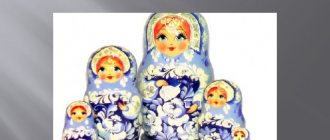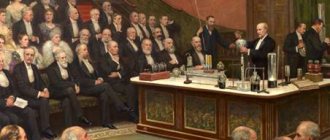A little history
In 1967, the capital's writer Yuri Bychkov went to Suzdal to collect the necessary historical material. During his trip, he visited other cities: Vladimir, Ivanovo, Kostroma.
Finding himself deeply impressed by the atmosphere of ancient Russian cities, Bychkov wrote an essay not about one, but about all the cities that came across his way during his travels.
Since the writer’s route ran along a circle, he decided to give it a beautiful name - “golden ring”.
Back then, Bychkov could not even imagine that after a while it would become a kind of calling card of one of the most popular tourist destinations in Russia.
Rice. 1. Golden ring on the map.
All cities included in the Golden Ring have a unique history. They witnessed the most important historical events and keep many secrets. It was here that Russian writers and painters drew inspiration, and the landscapes of these cities adorned many Russian films.
Cities of the Golden Ring of Russia
Traditionally, the Golden Ring list includes 8 major cities. Let's take a closer look at each of them.
TOP 4 articles that are read along with this
- 1. Sights of the Moscow Kremlin (2nd class, surrounding world)
- 2. Cities of Russia
- 3. Country of cities
- 4. Traveling around Russia
- Vladimir is a real treasury and the oldest city in Russia. In the 12th century it was the capital of the Vladimir-Suzdal principality, but over time the city lost its high status. On its territory, architectural monuments have been preserved in their original form: golden-domed temples, ancient wooden towers. Of particular value is the Assumption Cathedral, built in the 12th century and painted by Andrei Rublev.
Rice. 2. Assumption Cathedral.
- Suzdal is a small but very beautiful city, which can safely be called a museum city. Its small territory contains more than two hundred monuments of cultural and historical significance. Here you can admire such original buildings as the Church of Boris and Gleb, the Suzdal Kremlin, and the Ensemble of the Trade Square.
- Ivanovo is the “youngest” city of the Golden Ring. It was erected on the site of the village of the same name in 1871. Since then, the city has received many other names, including “City of Brides”, “Textile Capital of Russia”, “Cintz Land”. The attractions of Ivanovo include architectural buildings of the 20-30s of the last century. This period was called Soviet constructivism. All buildings are distinguished by strict, clear lines and impressive dimensions.
- Kostroma is a city with a rich history and at the same time it is one of the largest river ports in Russia. Compared to other cities of the Golden Ring, it stands out primarily for its religious architecture.
Of particular value is the male Holy Trinity Ipatiev Monastery, where Mikhail Romanov, the first Russian Tsar from the great Romanov dynasty, lived and was enthroned.
- Sergiev Posad - the largest monastery in Russia - the Trinity-Sergius Lavra - is located here. It was built in the 14th century and includes more than 50 different structures.
Rice. 3. Trinity-Sergius Lavra.
- Yaroslavl is one of the large cities, whose history goes back a thousand years. Included in the UNESCO World Heritage List. Like many other “golden” cities, there are many ancient architectural attractions here.
- Pereslavl-Zalessky is a small modest town, on the territory of which the Pleshcheyevo Lake national park is located. There are ancient buildings and unique museums here.
- Rostov the Great is one of the oldest cities of the Golden Ring. On its territory there are many valuable historical and cultural monuments, among which the Rostov Kremlin, as well as the Assumption Cathedral and its belfry, stand out.
"Journey along the Golden Ring of Russia"
Travel around
"Golden Ring"
Russia"
"Gold ring of Russia"
Golden ring
- a tourist route passing through the ancient cities of Central Russia, in which unique monuments of Russian history and culture, and centers of folk crafts have been preserved.
The Golden Ring traditionally includes eight main cities - Sergiev Posad, Pereslavl-Zalessky, Rostov Veliky, Yaroslavl, Kostroma, Ivanovo, Suzdal, Vladimir. In 2020, Uglich entered the Golden Ring tourist route.
Sergiev Posad
The only city in the Moscow region as part of the Golden Ring. Its main attraction is the Trinity-Sergius
Lavra
The Trinity Cathedral houses the relics of St. Sergius of Radonezh, and hundreds of pilgrims flock here every day. The cathedral is famous for its horizontal iconostasis, which was created by a team of craftsmen under the leadership of Andrei Rublev. On one of the doors of the temple there is a hole from a cannonball - a trace from the siege of the Lavra by the troops of False Dmitry II.
In the outskirts of the city there is the ancient Abramtsevo estate. Here Nikolai Gogol read to the owners of the estate, the Aksakov family, the second volume of Dead Souls; Valentin Serov wrote “Girl with Peaches”, and Andrei Tarkovsky filmed some scenes of “Solaris”.
a Bogorodsk toy as a souvenir from Sergiev Posad
- a carved wooden bear or colorful bird - which is driven by a hidden mechanism.
PERESLAVL-ZALESSKY
In the city on the shore of Lake Pleshcheevo you can see six monasteries and nine churches. Among them is the Transfiguration Cathedral
, in which, according to legend, Alexander Nevsky was baptized. The decoration of the temple differs from most Russian churches in its asceticism: practically no decor, a minimum of frescoes. The exception is a copy of the Transfiguration icon by Theophanes the Greek above the marble altar.
Lake Pleshcheyevo itself.
. It was here in the 17th century that Peter I began the construction of the “amusing flotilla,” the ancestor of the entire Russian fleet. Today, the “Boat of Peter I” is open here - a museum where the only boat “Fortune” that has survived from Peter’s times is exhibited. There is also a Blue Stone on the lake - it was used during rituals by the pagan Slavs. When it rains, the color of the stone changes from gray to blue - hence the name. Tourists make a wish at the Blue Stone and, to make it come true, tie a bright ribbon to a nearby bush, and leave a coin on the stone itself.
ROSTOV VELIKY
One of the oldest cities in Rus' was mentioned in the Tale of Bygone Years - in the chronicle of 862. Decorates the Rostov Kremlin XVII
century, which was built not to protect the city, but as the residence of the metropolitan. Leonid Gaidai made him famous throughout the country: the main characters of the film “Ivan Vasilyevich Changes His Profession” ran away from pursuit along the passages of the Rostov Kremlin.
The Assumption Cathedral is located in the Kremlin ensemble
- one of the most beautiful churches in Russia. Its architectural style is in many ways reminiscent of the Assumption Cathedral of the Moscow Kremlin. According to legends, the rector of this cathedral was the father of the hero Alyosha Popovich. The famous Rostov belfry with fifteen bells is also located near the cathedral. The largest of them - and the most major in sound - is “Sysoy”. It weighs 32 tons - it takes two bell ringers to rock this giant.
YAROSLAVL
The first thing in Yaroslavl is to go to the historical center of the city to the Church of Elijah the Prophet
. The elegant facade of this temple with snow-white walls, green domes, carved arches and colorful platbands has survived to this day almost in its original form. Ancient frescoes and a baroque carved iconostasis from the 17th century also survived. However, they are opened for visitors to the temple museum only in the warm season: damp and cold weather can cause irreparable damage to the images.
Yaroslavl Spaso-Preobrazhensky Monastery
famous for the fact that the only handwritten copy of “The Tale of Igor’s Campaign” that existed in the 18th century was discovered in his library. The monastery has preserved frescoes from the time of Ivan the Terrible (who, by the way, loved to be here), a refectory chamber and even some monastic cells.
It is also worth visiting the museum-reserve on the territory of the monastery, where visitors are introduced to the intricacies of Russian architecture and sculpture. Here you can also see ancient Slavic and Greek manuscripts, including the very copy of “The Tale of Igor’s Campaign.”
Kostroma
Having left the Ivanovskoye Highway, you can easily get to the next city of the Golden Ring - Kostroma
. At first, travelers are greeted by residential areas, but after crossing the bridge across the Volga, travelers are immediately greeted by the famous Trading Rows, ancient Linden trees, as well as the green domes of the Resurrection Church on Debra. The layout of the city is very interesting, it is a kind of fan, thanks to which all the central streets lead to the main square. This is extremely convenient for walking, since it is simply impossible to get lost in Kostroma.
As you look around the city, you can’t help but notice the ancient mansions with wrought iron fences, chimneys made of cut iron, massive oak gates and oddly shaped balconies. Much has been preserved here in its original form, so from time to time it seems that you are in the 19th century. Other attractions of the city include the Romanov Museum, the Fire Tower, and the Ipatiev Monastery.
Ivanovo
From Kostroma it is best to go to Ivanovo
, especially since if you travel by car, the distance can easily be covered in just 1.5-2 hours. It is noteworthy that, unlike previous cities, where tourists got acquainted with the monuments of ancient houses and cathedrals of the 12th-16th centuries, in Ivanovo the buildings of the 20th century are of interest. The monumental architecture of the Soviet style is presented here very clearly, and there are many such projects that a person will not find in any other city. While here, you should definitely check out buildings such as the Horseshoe House and the Bird House, the wings of which really look like the wings of a bird. There are also buildings in the shape of a ship with a sloping bow, a tower at the stern and balconies in the form of decks.
By visiting the local Museum of Local Lore, you can get to know the culture better, learn better the history of the city’s development, and epoch-making dates. Fans of Russian cars should check out the Museum of Russian Automotive Industry. After lunch, you can take a walk through the park of culture and recreation, where vacationers will find amazing forged figures of various animals from fairy tales and cartoons. It will be very interesting to explore the city from the top of the Ferris Wheel attraction.
SUZDAL
Suzdal Kremlin
was built back in the 10th century, and, surprisingly, almost all of its main buildings have survived to this day. Including the Church of the Nativity of the Virgin Mary with a special dome of rich blue color with gold stars. The Kremlin ensemble also includes the Bishops' Chambers: in ancient times, these stone buildings were used as residential and utility rooms, and today they house an exhibition dedicated to the history of the region.
The Suzdal Open-Air Museum of Wooden Architecture contains authentic buildings from the 17th–18th centuries. Peasant huts, merchant houses and even mills are open to the public. The museum staff recreated their interior decoration down to the smallest detail.
The Shchurovo Settlement Museum is a reconstruction of the settlement of the ancient Slavs. In 2008, she became the scenery for Pavel Lungin’s film “The Tsar”. Today, in the interactive museum, visitors are introduced to the life of the inhabitants of ancient Suzdal, taught how to bake bread in a real oven, shoot a bow and hold a sword correctly.
VLADIMIR
For two centuries, Vladimir was the nominal capital of North-Eastern Rus'. It was here, in the Cathedral of the Assumption of the Blessed Virgin Mary, that the great princes were married. This temple was built to store the icon of Our Lady of Vladimir, which was considered the patroness and protector of the state. Today the Assumption Cathedral is included in the UNESCO World Heritage List. Its white stone walls are covered with frescoes of the finest work, including works by Andrei Rublev.
Vladimir Golden Gate
built in the 12th century by Andrei Bogolyubsky. He wanted to show that the city is not inferior to Kyiv in influence and wealth. The gate became not only a beautiful architectural monument, but also a powerful defensive structure. They withstood the onslaught of the Tatar hordes during the siege of the city of Batu.
Also on the water meadows near Vladimir is one of the most famous Russian churches - the Church of the Intercession on the Nerl. The elegant temple looks light and weightless thanks to the combination of narrow and elongated decorative elements. The walls of the church are decorated with plot carved reliefs. The central motif of three of them was King David seated on the throne, surrounded by lions and doves.
Thank you for your attention!







